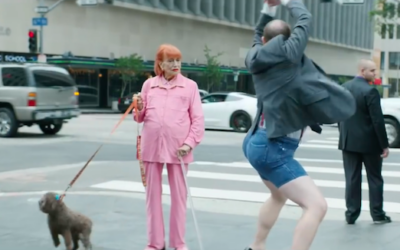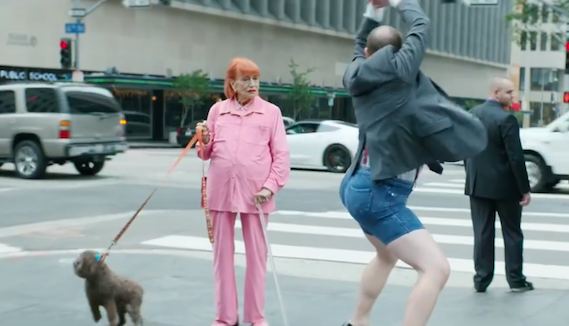TBWAManchester‘s Rebecca Brett writes about gendered thinking within the communication’s sector and what implications that has.
“It’s all in your head, you just have no idea how big your head is” – Lon Milo DuQuette
Before we learn to talk, expectations based on our sex are thrust upon us and, before we know it, we are straight-jacketed into believing in, conforming to, and projecting gender stereotypes.
Some of these stereotypes or assumptions can feel pretty harmless:
Baby girls in pink, baby boys in blue
But, they can manifest in things like product choices:
Proper men drink beer, women drink wine
Women wear heels (remember that temp who was sent home because she didn’t want to wear heels?)
And, as time goes on, we are cajoled into much starker and potentially darker stereotypes which shape our lives:
Men shouldn’t show emotion and certainly shouldn’t cry
All women want children

If you can’t see the problem here, think about placing these types of expectation and assumption upon people based on their race or ability:
Black babies in pink, white babies in blue
Disabled people shouldn’t show emotion and certainly shouldn’t cry
There would be outrage, wouldn’t there? So, why is it okay to do this based on gender?
Advertising and the media industry at large is held (and rightly so) responsible for the creation and perpetuation of these stereotypes.
Communications which utilise gender stereotypes are not inherently bad. Dave’s #EpicStrut in the Moneysupermarket.com campaign utilises and plays with stereotype to incongruously flip the script, maybe even highlighting the absurdity of sexualisation of women in media.
However, other advertising features more insidious messages which can limit how individuals perceive themselves and the decisions they make in life. This is specifically true of children whose sponge-like brains internalise messages more easily than adults.
Our industry is in the firing line because our brands and their communications are seen to be capitalising on harmful stereotypes.
In July of last year, the ASA banned gender stereotyping within UK advertising. A huge win in making sure our brands are helping to shape opinions and attitudes for the better rather than using their platform to reflect an outdated image of society.
In fact, many brands have seen the commercial light when it comes to breaking down stereotypes e.g. Always ‘Like a girl’, Lynx ‘Is it okay for guys’, Sport England ‘This Girl Can’ and so on. But, these are still ‘tentpole’ moments and in no way the norm.
Despite the fact that we are no longer permitted to promote classic stereotypes (the ‘domestic obsessive’ or the ‘incompetent dad’), we continue to allow gender bias to spill into our audience profiles.
Now, I am not saying that our industry does it on purpose. By definition, bias is ingrained. In fact, some of these assumptions are woven into our social fabric, and it can seem stupid to question them – but ‘stupid’ questions are often the best in the room, revealing ‘truth’ to be nothing more than assumption with a fancy shirt on.
There is no difference between Dave’s taste buds and mine when it comes to enjoying a pint. The only thing which tastes different is the biases we, and the brand owner, have picked up along the way.
Biases are hugely powerful. They are the product of the mind trying to make our lives easier by categorising and simplifying decisions for us. But these categories don’t always make sense. The mind is doing the easy thing, not necessarily the right thing. The good news is that these categories aren’t fixed; they are open to change.
Products aren’t rigidly fixed to gender; we are.
These biases feed into NPD and trickle down into our world affecting crucial communication choices.
Creatively, we can still project bias without the use of explicit stereotype. For example, if the advert features a largely ‘male’ setting then we may infer this product is for men.
In terms of media, if the advertising appears only in traditionally female channels then we infer that this product is for women.
These factors, although more nuanced, can be more powerful than the classic stereotype – insidiously so. At least with an explicit stereotype we can actively reject it, start a hashtag on Twitter and talk about the ridiculousness of it all in the pub. Bias, on the other hand, has a tendency to hide in the shadows in a way which makes it difficult to call out.
This means that:
(1) Brands continue to promote gender stereotypes – bad for society
(2) Brands continue to miss out on sales from the other gender – bad for business
As Byron Sharp, the latest IPA effectiveness research and various others indicate, for long term brand growth we should look to reach the biggest audience possible. For almost all products and services the largest addressable audience is not gender-restricted. The proof is in the pudding with the world’s largest brands, on the whole, ignoring gender in their audience profiles (Apple, Google, McDonalds and Amazon). So why is it that so many brands switch half the population off before they even start?
Of course it would make no commercial sense to promote products directly connected to biological difference to both sexes (birth control, tampons). And it is possible to play off gender differences – but this is only ever going to be a short term strategy as societal boundaries are in a constant state of flux. Actually, the most powerful and successful work appeals to human truth and refuses to limit itself to gender-specific truth.
In the end, we are duping ourselves creatively and commercially by not capitalising on the widest possible audience. By building our audience based on gender assumptions, we are always going to miss out on at least a slice of the sales pie.
So, how can we make sure we are not part of the problem? How can we address our bias and grow our brands?
Question whether your audience profile needs to be gender-specific
There are only sex-specific products, not gender-specific products.
Current user profiles are not ad infinitum. Just because a current user profile is fruitful now, doesn’t mean it will be in 5 years.
Question the audience profiles of your briefs and actively seek out its assumptions and biases. Easier said than done I know.
Think twice in creative reviews
The thing with subtlety is that it is difficult to detect.
We must actively out-think our own bias and the implicit bias in our work to make sure we aren’t unknowingly deterring half the population from interacting with our brand.
Build and nurture diverse teams
The more perspectives in the room, the more you will see. Diverse teams = diverse work – simple. The IPA’s latest annual diversity survey shows progress within the industry but more work needs to be done in building and nurturing diverse talent.
Be part of the media briefing
Question your media audience.
The creative work might be saying the right things, but that is futile if not said to the right people.
Great work breaks down invisible boundaries. But before we break them down we have to understand the boundaries we place upon the world we live in.
Brett is from TBWAManchester and the feature is part of the agency’s Disruption Diary series.










